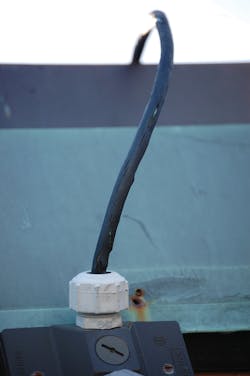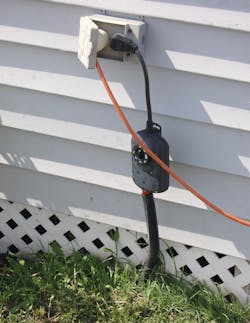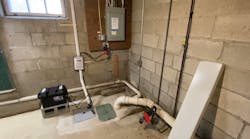Not So Fun in the Sun
This cord has reached its breaking point. It has become dry, brittle, and cracked due to exposure to sunlight and the other elements of nature, such as snow, rain, and extremely cold temperatures. It should be replaced. The cracks in the outer jacket will allow water and moisture to seep into the cord and possibly into the box, causing even more damage to the conductor splices. Section 400.3 requires flexible cords and flexible cables to be a type suitable for the conditions of use. Table 400.4 helps installers choose the right type of cord or cable for any application. Note 9 for the Table informs us that cords with a “W” suffix is suitable for use in wet locations and locations exposed to direct sunlight. Table 400.4 also provides examples of cords that may be permitted for this location including SJOW and SOW cords, among others. This hard-wired cord was being used for connection to adjustable metal-halide floodlights as permitted by Sec. 410.62(B). Cord-and-plug connections are not required for this type of installation. I’m not sure of the type of cord used here because the jacket was too damaged to read its markings.
Crazy Cord Connections
This receptacle cover is not only mounted in the wrong position, it’s the completely wrong type of cover in the first place. This cover is designed to be installed so it can open vertically, not horizontally. Installing covers in the wrong position violates the requirements of Sec. 110.3(B) if the listing and instructions require a certain orientation such as “vertical only.” For wet locations, Sec. 406.9(B)(1) requires 15A and 20A, 125V and 250V receptacles to have an enclosure that is weatherproof even when an attachment lug cap is inserted. The cover in the photo would only be weatherproof when it was closed, and of course, if it was mounted in the correct position. Another concern I have is with the extension cord plugged into the timer. It was run underground beneath the grass approximately 100 ft to provide power to a boat dock on a lake. That does not seem safe at all. The cord is not designed to be buried in the ground. Using cord sets in this manner to provide power to the dock area could create a dangerous shock hazard in and around the water if this cord gets damaged. It also violates the requirements of Sec. 400.12(7).






